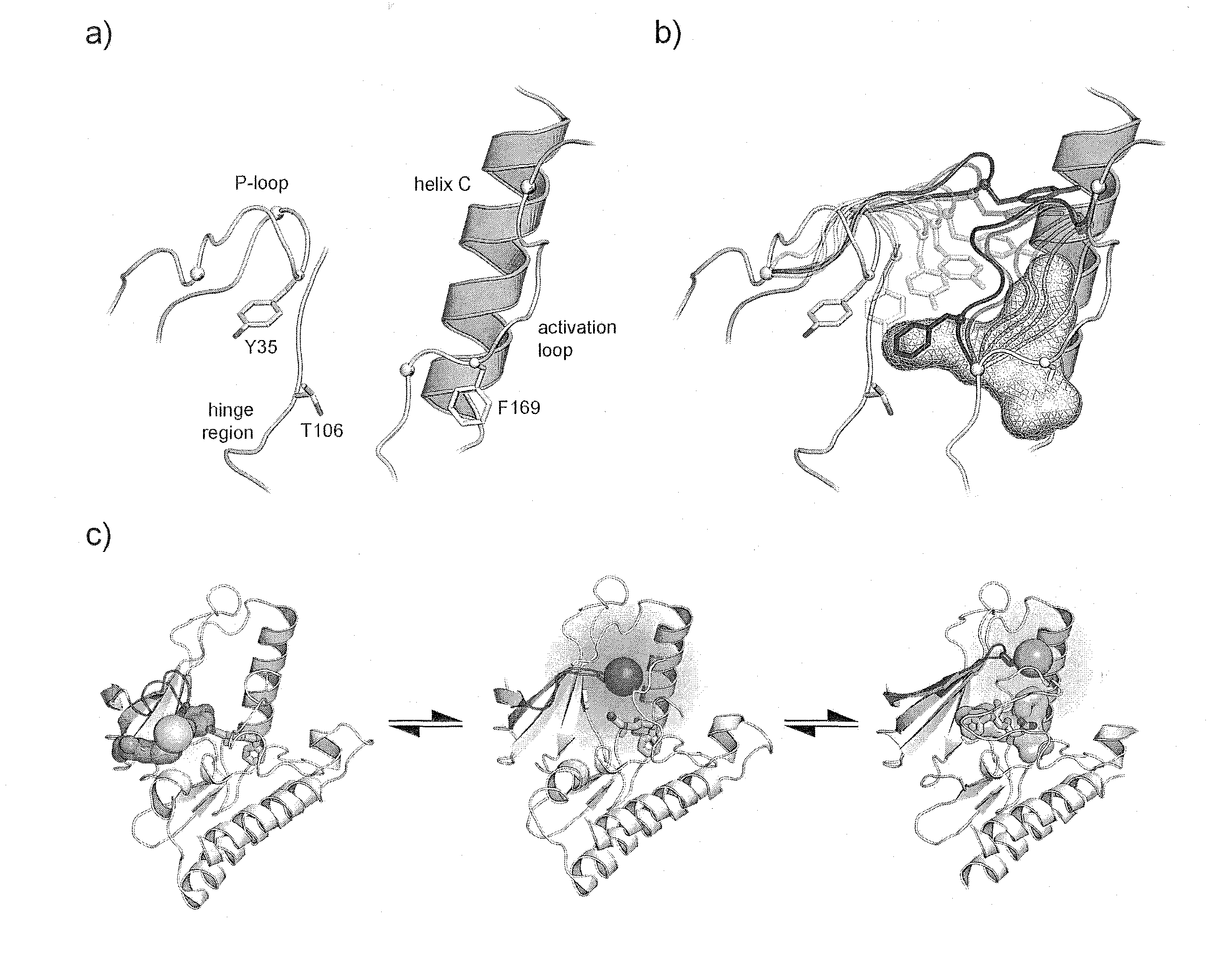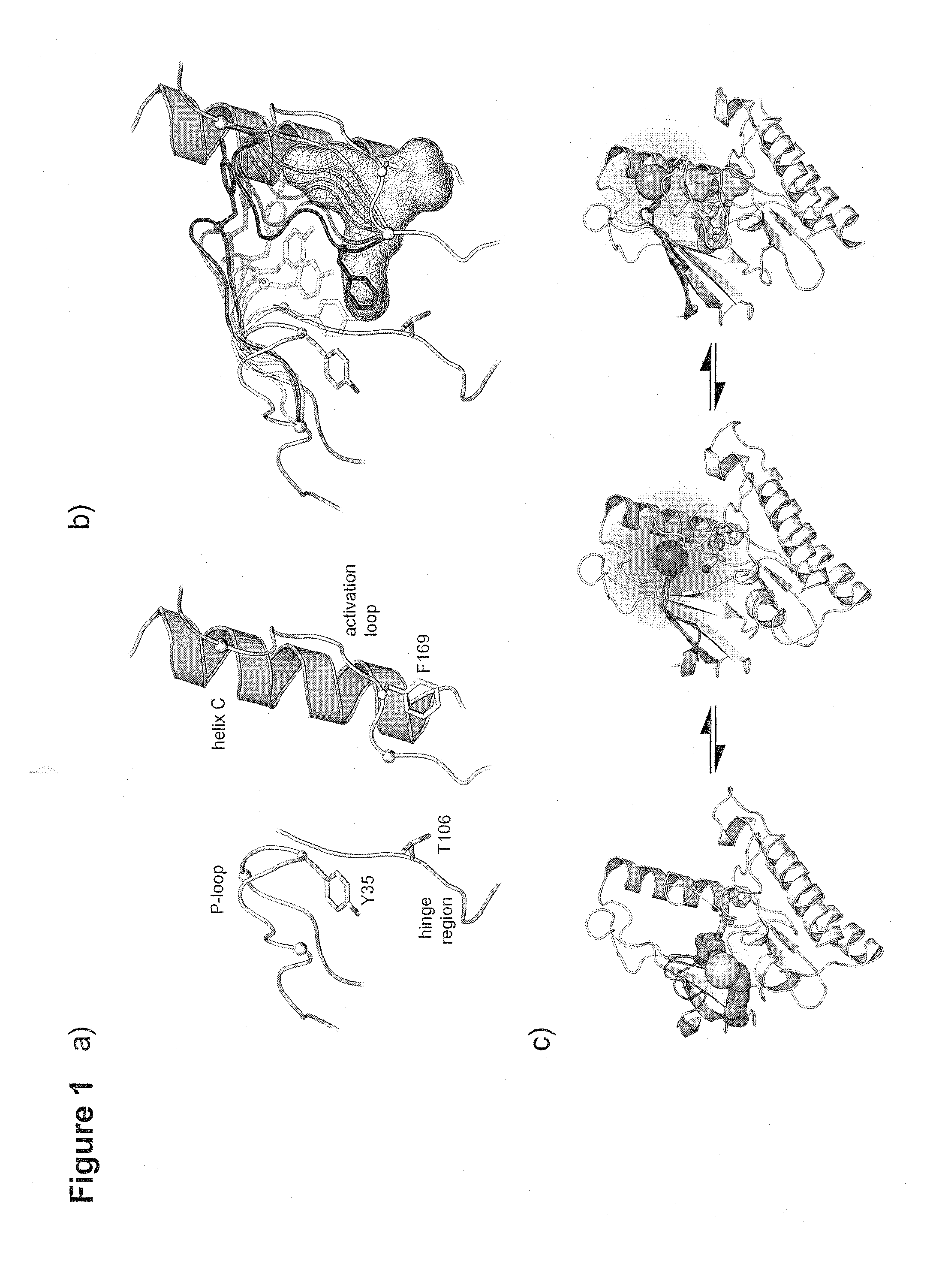Development of fluorescently p-loop labelled kinases for screening of inhibitors
a technology of fluorescently p-loop labelled kinases and inhibitors, which is applied in the direction of transferases, instruments, enzyme stabilisation, etc., can solve the problems of poor inhibitor selectivity and efficacy, and the type of inhibitors
- Summary
- Abstract
- Description
- Claims
- Application Information
AI Technical Summary
Benefits of technology
Problems solved by technology
Method used
Image
Examples
example 1
Selection of a Suitable Kinase
[0166]Applicants chose to work with p38α to develop this assay for the following reasons: i) the abundance available of structural information, ii) the availability of crystal structures in both its active and inactive conformations (FIG. 1A.) and iii) the availability of tight binding Type II & III allosteric inhibitors. In the first step, the crystal structures of p38α were closely examined to identify suitable fluorophore attachment sites that would detect allosteric binders. Candidate residues for this mutation must be solvent exposed to enable the attachment of a fluorophore by Michael addition, and exhibit significant movement upon ligand binding. Care was also taken to not choose residues that are critical to maintaining protein stability, catalytic activity or residues in the vicinity of known phosphorylation sites.
[0167]A position in P-loop (Tyr35) was selected and subsequently mutated into a cysteine residue (FIG. 1B.,C.). Acrylodan was select...
example 2
Protein Labelling and Fluorescence Characterization
[0169]A p38α construct containing 4 total mutations (2 cysteine→serine, and the introduction of a cysteine for labelling) was transformed into the BL21(DE3) E. coli strain, overexpressed, purified by affinity, anion exchange and size exclusion chromatography and the pure protein was subsequently used for labelling. Protein and free acrylodan were combined at a 1:1.5 ratio and allowed to react in the dark overnight at 4° C. The conjugated protein (ac-p38α) was concentrated, aliquoted and frozen at −20° C. Mono-labelling of 100% of the protein was verified by ESI-MS. Confirmation of the correctly labelled cysteine is currently being performed by analyzing the tryptic fragments of unlabelled and labelled p38α following a combination of HPLC and ESI-MS or MALDI.
Fluorescence Characterization
[0170]Following labelling, the fluorescent properties of the probe were characterized and initial experiments were carried out using...
example 3
Endpoint and Kinetic Measurements—Methods
[0172]To characterize the present labelling strategy, p38α labelled with acrylodan at the glycine-rich loop (50 nM) was screened against a small subset (˜400) of compounds based on scaffolds that are generally known to be privileged for binding to the DFG-in or DFG-out conformation of kinases. The kinase was pre-incubated with various concentrations of inhibitor before endpoint fluorescence measurements were carried out in either polystyrene cuvettes or 384-well plates to determine the Kd of each compound. A standard buffer (50 mM Hepes, 200 mM NaCl, pH 7.45) was used for all experiments. For cuvette measurements, incubations were carried out overnight in the dark at 4° C. for p38α. For HTS formats, incubations were carried out for up to 5 h at room temperature. Long incubation times are needed to account for the time-dependence of Type II inhibitor binding to p38α (Pargellis et al., 2002).
[0173]In the cuvette format, a series of cuvettes con...
PUM
| Property | Measurement | Unit |
|---|---|---|
| emission wavelength | aaaaa | aaaaa |
| time | aaaaa | aaaaa |
| pH | aaaaa | aaaaa |
Abstract
Description
Claims
Application Information
 Login to View More
Login to View More - R&D
- Intellectual Property
- Life Sciences
- Materials
- Tech Scout
- Unparalleled Data Quality
- Higher Quality Content
- 60% Fewer Hallucinations
Browse by: Latest US Patents, China's latest patents, Technical Efficacy Thesaurus, Application Domain, Technology Topic, Popular Technical Reports.
© 2025 PatSnap. All rights reserved.Legal|Privacy policy|Modern Slavery Act Transparency Statement|Sitemap|About US| Contact US: help@patsnap.com



